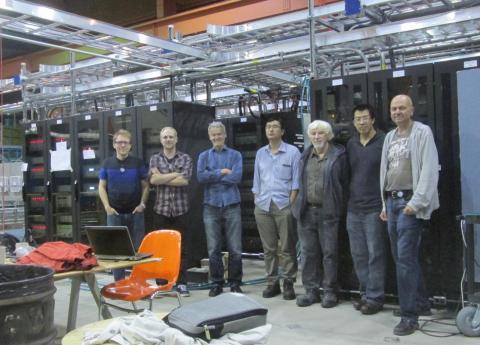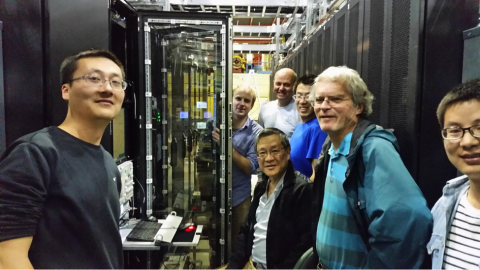

The campaign to demonstrate 10 MV/m accelerating gradient in the superconducting radio-frequency (SRF) cavities of the E-linac Injector (EINJ) and Accelerator (EACA) cryomodules achieved two critically important milestones last week: On Sept 23rd, the EINJ cavity reached 12 MV/m in continuous wave (c.w.) operation, exceeding design specification, and on September 24th, the EACA cavity reached 10 MV/m in c.w. operation, meeting design specification!
To reach high gradient means the ability to accelerate a particle beam to a high voltage in a short distance; in this case 10 million electron volts over 1 metre of length! To achieve this, high power from the klystrons, on the order of 20 kW, is fed to the cavity through input couplers.
On Sept 23rd, the SRF squad produced initial results on the EINJ cavity. “We have reached 12 MV/m in both pulsed (2% duty factor) and c.w. mode. The cavity looks clean – the present limitation is only in the coupler conditioning,” reported Bob Laxdal, the SRF Group Leader.
And on Sept 24th, the SRF squad pushed the EACA performance to 10 MV/m in c.w. operation. This builds on previous tests conducted Sept 10-13, where the EACA cavity attained 7 MV/m in c.w. and 10 MV/m in pulsed operation. "We had no doubt that the input coupler conditioning in the intervening period would make a difference, and it paid off," says SRF Engineer Vladimir Zvyagintsev. "We will continue to condition in the coming days to further improve the performance."
The significance of the two results is that the cavities have reached or exceeded the specified performance for acceleration and rf power and the team believes they can go higher. “This paves the way to accelerate the electron beam up to 25 MeV later this week”, says E-linac Project Leader Shane Koscielniak. “The SRF results are pivotal to the project, and I am excited that we will be commissioning the linac with electron beam this week,” he added.
The campaign leading to the SRF 10 Mega-Volt Milestones was five years in the making. The SRF team collaborated with the Canadian company PAVAC Industries to produce the first multi-cell elliptical cavities built in Canada, which were then processed and individually characterized in TRIUMF test cryostats, developed specifically for the ARIEL project. Several tests were required before the cavities were sufficiently optimized for assembly into the cryomodules. The cryomodules are the life support systems for the cavities – a super-thermos that allows control of the cavity while keeping it thermally isolated. Their complex design was done completely in house by the SRF team over a three year period. The two cryomodules (EINJ and EACA) have been assembled. Critical for the performance is assembly in a Class 10 clean room to keep the rf surfaces free from dust that would reduce performance.
The cryomodules were installed in the Electron Hall during the spring and summer. A cryogenic distribution system connects the two cryomodules to the cryogenic service allowing the supply of 77 Kelvin liquid Nitrogen (LN2) for thermally shielding and 4 Kelvin liquid Helium (LHe) to cool the cavities. The final cooling of the RF cavity to 2 Kelvin is accomplished by sub-atmospheric pumping.
Two new 300 kW klystrons were installed, commissioned and connected to the cryomodules with waveguides (read more here), while two sophisticated TRIUMF designed control systems were installed and commissioned to regulate the voltage produced by the cavity. The multitude of control and diagnostic cables were interfaced to the e-linac EPICS control system, and the thermal isolation volume and the cavity/beamline volume were evacuated and leak tested. The cooling of the cryomodules proceeded very smoothly and the cryogenic performance of the modules was measured and matched the design specification. Bob Laxdal confirmed, "The cryo-engineering of the modules is very solid – all aspects of the performance reflect the design requirements."
With heroic efforts on behalf of many TRIUMF groups, including cryogenics, controls, vacuum, high power and low level RF, preparations were complete for the SRF group to begin to characterize the cavity performance. The first step in applying radio-frequency power (to each cryomodule) was to condition the two input couplers; RF waves are applied to their interior metallic surfaces to eliminate electron emission. A key step was to tune the coupler and cavity so that RF power goes into the cavity, rather than being reflected away from it. “Achieving ‘lock’ of the RF components all to the same frequency is a big moment that unites hardware, electronics of the low level RF system, and controls,” Shane pointed out.
The power from the klystron was increased slowly from a few 100 Watts to the 20 kW level, first in pulsed mode and then in continuous mode. Interlock checks were done to avoid the potential of a rapid heating of the helium due to an errant rf event. In the end all aspects of the power delivery, cryogenics, cryo-engineering, low level rf and cavity performance were successful. Vladimir Zvyagintsev, SRF Engineer, was part of the team to ‘energize’ the cavities. "It is very unusual to bring up a high power cold cavity system in such a short time, but to bring up two systems in two consecutive nights is remarkable and speaks to the quality of the installation.”
"The rf milestones this week represent an enormous effort by a talented team. We are proud of what they have accomplished," stated Bob Laxdal.
All the hard work has paid off. The ARIEL e-linac met its Mega-Volt Milestones. The ARIEL-1 project is on target!
–Prepared by Shane Koscielniak, Lia Merminga, and Bob Laxdal.
Top photo: The “10MV/m SRF squad”: R. Nagimov, P. Kolb, R. Laxdal, Y.Y. Ma, W. Rawnsley, Z. Yao, V. Zvyagintsev.
Bottom photo: “Cavity successfully energized”. The team: Chang Wei (visitor from IMP), P. Kolb, K. Fong, V. Zvyagintsev, Z. Yao, M. Laverty, Liu Yang.
